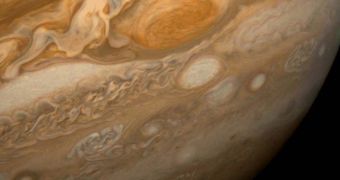The largest and heaviest planet in our solar system is apparently well on its way to destroying its own core, a complex set of analyses has revealed recently. The most interesting implication of the new work is that the largest gas giant extrasolar planets may not have a core at all.
Analyzing what goes on on Jupiter is important from two main points of view – one, whatever happens to it affects everything else in the solar system except the Sun, and two, it can be used as a proxy for exoplanetary studies.
Jupiter is nearly twice as heavy as all other planets combined, and its presence is essential to the current configuration of the solar system. If it were to deviate from its current orbit, it move drag all other giants with it, and together they could obliterate Earth, Mars, Venus and Mercury.
At the same time, most exoplanets discovered by the NASA Kepler Telescope, the CoRoT mission and other observatories were large planets, many of which were larger than Jupiter. As such, the new work provides experts with an interesting avenue to conduct new science.
The team that conducted the new research – based at the University of California in Berkeley – was led by Hugh Wilson and Burkhard Militzer, who are both planetary scientists. Their work also reveals that the gases which made Jupiter a gas giant may be responsible for the current state of affairs.
The planet is mostly composed of hydrogen and helium, which explains why they got to be so big. What is different on Jupiter from Saturn, for instance, is the fact that its enormous gravitational pull is squashing the hydrogen into a weird, conducting liquid.
This state of matter surrounds a solid planetary core made up of rocks, ice and iron, which is only about 10 times heavier than our planet. The entire planet tips the scales at 318 Earth masses. The UCB team conducted its experiments based on these data.
They calculated what would happen when one of the most important elements in Jupiter's core, magnesium oxide (MgO) is submerged into the type of hydrogen-helium fluid that experts know permeates Jupiter's core, ScienceNow reports.
Using quantum mechanical calculations, the group created a model were the liquid was subjected to temperature of 16,000 Kelvin and pressures of 40 million atmospheres. The main conclusion was that the solid rocks containing MgO are melting.
In a paper submitted to the journal Physical Review Letters, the team argues that – most likely – the gas giant's core is a lot smaller than it was when the planet first formed, more than 4 billion years ago.
This study could conceivably enable researchers to figure out how the planet evolved over time. “If we can do that, then we can make a very useful statement about what Jupiter was like at genesis,” David Stevenson of Caltech explains. He was not a part of the new study.

 14 DAY TRIAL //
14 DAY TRIAL //